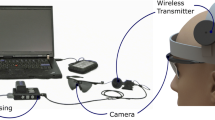Abstract
An active intraocular prosthesis is herein proposed as a new image acquisition device for a cortical visual prosthesis. A conventional intraocular prosthesis is a passive device that helps blind patients underwent eye enucleation to maintain the shape of an eyeball. In contrast, an active intraocular prosthesis, which works as an implantable wireless camera, can capture real-time images and transmit them to a cortical visual prosthesis to restore partial vision of the patients. This active device has distinct advantages in that it can garner a variety of image information while focusing on objects in accordance with natural eye movements, compared with a glasses-mounted camera and implanted micro-photodiodes in typical artificial vision systems. Coated with an epoxy and sealed by an elastomer for biocompatibility as well as durability, the active intraocular prosthesis was fabricated in a spherical form miniaturized enough to be inserted into the eye. Its operation was evaluated by wireless image acquisition displaying a processed gray-scale image. Furthermore, signal-to-noise ratio measurements were conducted to find a reliable communication range of the fabricated prosthesis, while it was covered by an 8-mm-thick biological medium that mimicked in vivo environments. In conclusion, the feasibility of the active intraocular prosthesis to cooperate with a cortical visual prosthesis is discussed.




Similar content being viewed by others
References
Klauke S, Goertz M, Rein S, Hoehl D, Thomas U, Eckhorn R, et al. Stimulation with a wireless intraocular epiretinal implant elicits visual percepts in blind humans. Invest Ophthalmol Vis Sci. 2011;52:449–55.
Fujikado T, Kamei M, Sakaguchi H, Kanda H, Morimoto T, Ikuno Y, et al. Testing of semichronically implanted retinal prosthesis by suprachoroidal-transretinal stimulation in patients with retinitis pigmentosa. Invest Ophthalmol Vis Sci. 2011;52:4726–33.
Stingl K, Bartz-Schmidt KU, Besch D, Braun A, Bruckmann A, Gekeler F, et al. Artificial vision with wirelessly powered subretinal electronic implant alpha-IMS. Proc R Soc B. 2013. https://doi.org/10.1098/rspb.2013.0077.
Weiland JD, Cho AK, Humayun MS. Retinal prostheses: current clinical results and future needs. Ophthalmology. 2011;118:2227–37.
Finn AP, Grewal DS, Vajzovic L. Argus II retinal prosthesis system: a review of patient selection criteria, surgical considerations, and post-operative outcomes. Clin Ophthalmol. 2018. https://doi.org/10.2147/OPTH.S137525.
Rizzo JF III. Update on retinal prosthetic research: the Boston Retinal Implant Project. J Neuro Ophthalmol. 2011;31:160–8.
Chuang AT, Margo CE, Greenberg PB. Retinal implants: a systematic review. Brit J Ophthalmol. 2014;98:852–6.
Luo YHL, Da Cruz L. The Argus® II retinal prosthesis system. Prog Retin Eye Res. 2016;50:89–107.
Shepherd RK, Shivdasani MN, Nayagam DA, Williams CE, Blamey PJ. Visual prostheses for the blind. Trends Biotechnol. 2013;31:562–71.
Cohen N. The totally implantable cochlear implant. Ear Hear. 2007;28:100S–1S.
Chow AY, Pardue MT, Chow VY, Peyman GA, Liang C, Perlman JI, et al. Implantation of silicon chip microphotodiode arrays into the cat subretinal space. IEEE Trans Neural Syst Rehabil Eng. 2001;9:86–95.
Stingl K, Bartz-Schmidt KU, Besch D, Chee CK, Cottriall CL, Gekeler F, et al. Subretinal visual implant alpha IMS-clinical trial interim report. Vis Res. 2015;111:149–60.
Chai X, Li L, Wu K, Zhou C, Cao P, Ren Q. C-sight visual prostheses for the blind. IEEE Eng Med Biol Magazine. 2008;27:20–8.
Lewis PM, Ackland HM, Lowery AJ, Rosenfeld JV. Restoration of vision in blind individuals using bionic devices: a review with a focus on cortical visual prostheses. Brain Res. 2015;1595:51–73.
Yue L, Weiland JD, Roska B, Humayun MS. Retinal stimulation strategies to restore vision: fundamentals and systems. Prog Retin Eye Res. 2016;53:21–47.
Foroushani AN, Pack CC, Sawan M. Cortical visual prostheses: from microstimulation to functional percept. J Neural Eng. 2018. https://doi.org/10.1088/1741-2552/aaa904.
Niketeghad S, Pouratian N. Brain machine interfaces for vision restoration: the current state of cortical visual prosthetics. Neurotherapeutics. 2019;16:134–43.
Gomez C, Oller J, Paradells J. Overview and evaluation of bluetooth low energy: an emerging low-power wireless technology. Sensors. 2012;12:11734–53.
Al-Kalbani AI, Yuce MR, Redouté, JM. Safe SAR levels in inductively powered brain implanted visual prostheses. In: Proceedings of international symposium on electromagnetic compatibility-EMC EUROPE. IEEE; 2012. pp 1–6.
Ahn SH, Jeong J, Kim SJ. Emerging encapsulation technologies for long-term reliability of microfabricated implantable devices. Micromachines. 2019;10:508–29.
Lee SW, Min KS, Jeong J, Kim J, Kim SJ. Monolithic encapsulation of implantable neuroprosthetic devices using liquid crystal polymers. IEEE Trans Biomed Eng. 2011;58:2255–63.
Cha K, Horch K, Normann RA. Simulation of a phosphene-based visual field: visual acuity in a pixelized vision system. Ann Biomed Eng. 1992;20:439–49.
Oghogho I, Edeko FO, Emagbetere J. Measurement and modelling of TCP downstream throughput dependence on SNR in an IEEE802 11b WLAN system. J King Saud Univ Eng Sci. 2018;30:170–6.
Kolb H. Gross anatomy of the eye. In: Webvision: The Organization of the Retina and Visual System [Internet]. University of Utah Health Sciences Center; 2017.
Todd TW, Beecher H, Williams GH, Todd AW. The weight and growth of the human eyeball. Hum Biol. 1940;12:1–20.
Acknowledgements
This work was supported in part by the Grant to CABMC funded by Defense Acquisition Program Administration (UD170030ID) and in part by the Samsung Electronics Corp. (#5264-20180116).
Author information
Authors and Affiliations
Corresponding author
Ethics declarations
Conflict of interest
Shim S, Seo K, and Kim SJ declare that they have no conflict of interest in relation to the work in this article at the time of this writing.
Additional information
Publisher's Note
Springer Nature remains neutral with regard to jurisdictional claims in published maps and institutional affiliations.
Rights and permissions
About this article
Cite this article
Shim, S., Seo, K. & Kim, S.J. A preliminary implementation of an active intraocular prosthesis as a new image acquisition device for a cortical visual prosthesis. J Artif Organs 23, 262–269 (2020). https://doi.org/10.1007/s10047-020-01168-x
Received:
Accepted:
Published:
Issue Date:
DOI: https://doi.org/10.1007/s10047-020-01168-x



